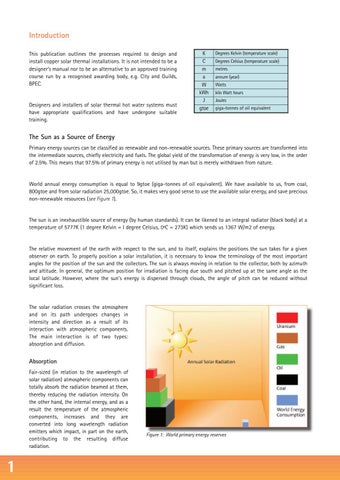Introduction This publication outlines the processes required to design and install copper solar thermal installations. It is not intended to be a designer’s manual nor to be an alternative to an approved training course run by a recognised awarding body, e.g. City and Guilds, BPEC.
Designers and installers of solar thermal hot water systems must have appropriate qualifications and have undergone suitable training.
K C m a W kWh J gtoe
Degrees Kelvin (temperature scale) Degrees Celsius (temperature scale) metres annum (year) Watts kilo Watt hours Joules giga-tonnes of oil equivalent
The Sun as a Source of Energy Primary energy sources can be classified as renewable and non-renewable sources. These primary sources are transformed into the intermediate sources, chiefly electricity and fuels. The global yield of the transformation of energy is very low, in the order of 2.5%. This means that 97.5% of primary energy is not utilised by man but is merely withdrawn from nature.
World annual energy consumption is equal to 9gtoe (giga-tonnes of oil equivalent). We have available to us, from coal, 800gtoe and from solar radiation 25,000gtoe. So, it makes very good sense to use the available solar energy, and save precious non-renewable resources (see Figure 1).
The sun is an inexhaustible source of energy (by human standards). It can be likened to an integral radiator (black body) at a temperature of 5777K (1 degree Kelvin = I degree Celsius, 0ÂşC = 273K) which sends us 1367 W/m2 of energy.
The relative movement of the earth with respect to the sun, and to itself, explains the positions the sun takes for a given observer on earth. To properly position a solar installation, it is necessary to know the terminology of the most important angles for the position of the sun and the collectors. The sun is always moving in relation to the collector, both by azimuth and altitude. In general, the optimum position for irradiation is facing due south and pitched up at the same angle as the local latitude. However, where the sun's energy is dispersed through clouds, the angle of pitch can be reduced without significant loss.
The solar radiation crosses the atmosphere and on its path undergoes changes in intensity and direction as a result of its interaction with atmospheric components. The main interaction is of two types: absorption and diffusion.
Absorption Fair-sized (in relation to the wavelength of solar radiation) atmospheric components can totally absorb the radiation beamed at them, thereby reducing the radiation intensity. On the other hand, the internal energy, and as a result the temperature of the atmospheric components, increases and they are converted into long wavelength radiation emitters which impact, in part on the earth, contributing to the resulting diffuse radiation.
1
Figure 1: World primary energy reserves






